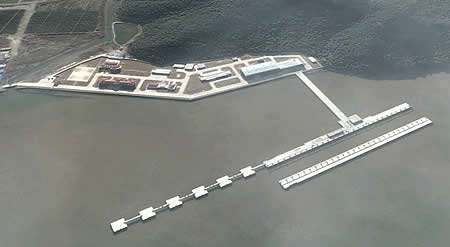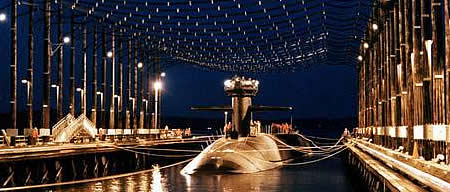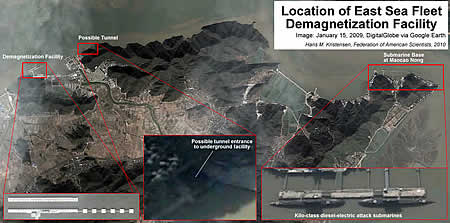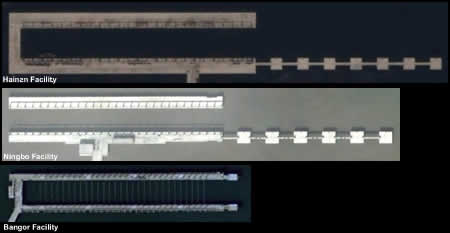Second Chinese Naval Demagnetization Facility Spotted
 |
| Click image for large version |
.
By Hans M. Kristensen
The Chinese navy has constructed what appears to be a demagnetization facility near an East Sea Fleet submarine base.
The facility is the second spotted at Chinese naval bases since 2008.
Chinese Naval Demagnetization Facilities
The new demagnetization facility is located less than 10 km from the Kilo submarine base at Maocao Nong approximately 40 km southeast of Ningbo in the Zhejiang province.
Seven Kilo-class submarines were visible at the base on January 15, 2009, nearly a third of the roughly 19 diesel-electric attack submarines that are deployed with the East Sea Fleet.
.
The East Sea Fleet facility was built between August 2007 and March 2008.
The East Sea Fleet facility is the second known Chinese demagnetization facility. In April 2008, I identified the first such facility at the South Sea Fleet base near Yulin on Hainan Island.
The South Sea Fleet facility was constructed sometime between January 2006 and February 2008.
.
The two demagnetization facilities are similar but with differences. The South Sea Fleet facility is built in a c-shape, similar to the U.S. design. The East Sea Fleet facility, which is located in a river, consists of two parallel piers, perhaps to accommodate strong currents.
The Purpose of Demagnetization
Demagnetization is conducted before deployment to remove residual magnetic fields in the metal of a vessel to make it harder to detect by other submarines and surface ships. It reduces the ship’s vulnerability to mines that are triggered by magnetic signals from metal hulls. Demagnetization apparently also can improve the speed of the vessel.
| Demagnetization of Ballistic Missile Submarine |
 |
| A U.S. SSBN is prepared for demagnetization at the Kitsap Naval Submarine Base near Bangor, Washington. The U.S. Navy has such facilities on both coasts. |
.
Both submarines and surface ships are demagnetized at regular intervals.
Nuclear-powered submarines including SSBNs are based at the North Sea and South Sea Fleets, but not at the East Sea Fleet. I suspect that we’ll see construction of a North Sea Fleet demagnetization facility soon.
Some Implications
Occasional Chinese naval force operations get prominent attention in western news media, such as the recent transit between Okinawa and Miyako Island of eight destroyers and two submarines. Routine operations by U.S. forces, on the other hand, are rarely described except when they involve large exercises or when incidents occasionally expose secret options such as the Impeccable incident in 2009.
Mining of harbors and costal areas would likely be an important mission for both U.S. and Chinese attack submarines and anti-submarine warfare forces in a hypothetical military conflict between China and the United States. Chinese naval forces have, despite ongoing modernization, significant technological and operational deficiencies.
So why has China not constructed naval demagnetization facilities earlier? After all, other naval powers have done so for decades after German engineers during World War II invented the magnetic mine. According to one report, China appears to have used degaussing vessels rather than fixed facilities.
Perhaps construction now reflects acquisition of new technology, a decision that fixed facilities are more efficient than degaussing vessels, or that modifications to China’s naval strategy make demagnetization more important.
Whatever the motivation, the construction of demagnetization facilities at China’s fleets are clear tell-signs of the cat-and-mouse game that is in full swing in the region between the naval forces of China and the United States and its Asian allies.
This publication was made possible by a grant from Carnegie Corporation of New York and Ploughshares Fund. The statements made and views expressed are solely the responsibility of the author.
The FY2026 National Defense Authorization Act (NDAA) paints a picture of a Congress that is working to both protect and accelerate nuclear modernization programs while simultaneously lacking trust in the Pentagon and the Department of Energy to execute them.
While advanced Chinese language proficiency and cultural familiarity remain irreplaceable skills, they are neither necessary nor sufficient for successful open-source analysis on China’s nuclear forces.
Satellite imagery has long served as a tool for observing on-the-ground activity worldwide, and offers especially valuable insights into the operation, development, and physical features related to nuclear technology.
This report outlines a framework relying on “Cooperative Technical Means” for effective arms control verification based on remote sensing, avoiding on-site inspections but maintaining a level of transparency that allows for immediate detection of changes in nuclear posture or a significant build-up above agreed limits.

